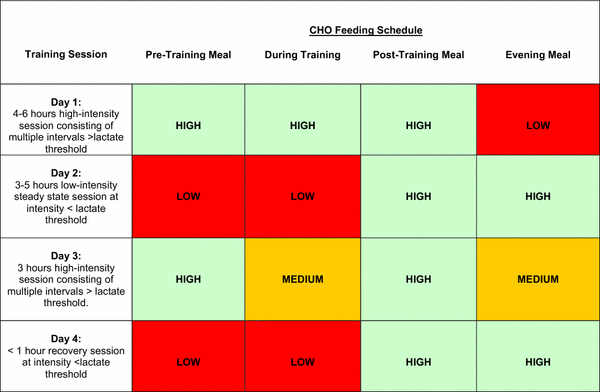
Nutritional Periodisation – The Fundamentals
Adaptive response to training can be determined by a combination of factors; the duration, the intensity, the type and frequency. But what is becoming more apparent, is that the nutrition we consume pre and post exercise can both amplify or even dampen the adaptations sought after.
For example, failing to consume a sufficient quantity of protein can result in a negative protein balance thus impeding cell repair. Over consumption of antioxidants post exercise, may in fact mitigate hypertrophy by inhibiting the inflammatory responses necessary for activating the signalling pathways involved in muscle growth (1). Intentionally under consuming carbohydrate prior to endurance exercise may promote the activation of signalling pathways that facilitate the growth of mitochondria- the powerhouse of the cell involved in aerobic exercise (2).
There are numerous interactions between nutrition and exercise that ultimately determine long-term exercise adaptations. Understanding how to prioritise our dietary intake can optimise our efforts that may otherwise be thwarted were they ignored. The purpose of this article is to clearly define what periodised nutrition is and provide methods for applying it to your own training.
What is periodised nutrition?
The word ‘periodised’ in the context of exercise refers to a long-term progressive approach which is meticulously managed to improve athletic performance. Take olympic athletes for example, who systematically vary training throughout the four year cycle between competitions with the objective of peaking at the right moment. Nutrition periodisation has the same connotations; the micromanagement of diet in respect of training type, intensity and objective in the endeavour of improving performance.
To put it more succinctly, Asker Juekendrup, world leading sports nutritionist, defined periodised nutrition as “the planned, purposeful and strategic use of specific nutritional interventions to enhance the adaptations targeted by individual exercise sessions or periodic training plans, or to obtain other effects that will enhance performance long term”. (3)
For example, a rugby team will undergo periods of training where the priority is to focus on weight management. Energy intake must therefore be restricted in accordance with this objective. Alternatively, a bodybuilder will purposefully attempt to build muscle by focusing on performance and recovery. During this phase, they must strategically adjust carbohydrate and energy intake in lieu of maintaining a lean physique.
Team Sky cycling are the most renowned for applying this method of approach. Using carbohydrate periodisation, they have become the most successful professional cycling team on the UCI World Tour, winning the Tour de France five out of the last six years. Team Sky have revolutionised periodised nutrition, coining the term ‘train-low, compete-high’ – more on this to come.
Ways to periodising nutrition
The secondary purpose of this article is to explain how nutrition periodisation can be specified to your own training. While there are several methods of periodisation nutrition intake, this article will discuss only those which have been extensively studied, and are supported by a proven ability to produce an intended result.
Side note: New approaches to diet have become all too pervasive. Guru’s make claim to have discovered the ultimate diet panacea for health and performance on a weekly basis (with very little proof or only anecdotal evidence to validate effectiveness). Despite the fact that expert opinion is considered the weakest form of evidence – wherein the risk of bias is greatest – it can be difficult to refrain from falling prey to an approach that almost seems too good to be true. Only when a diet has been stringently tested in the arena of academic research, critically evaluated by systematic reviews and meta-analysis should it be promoted and applied.
Training With Low Muscle Glycogen
“Train low” is a general description of exercising with low-carbohydrate availability. This could be low muscle glycogen, low liver glycogen and/or low carbohydrate intake during or after exercise. I will try to explain how this works in a simple way as possible. For a more in depth explanation, you may be interested in reading (4) and (5).
The rationale behind the train low theory is predicated on the observation that exercise alters gene expression- meaning a process by which specific genes are activated to produce a required protein. For example, we lift weights, gene expression occurs, muscle cells begins to repair. Spending time observing this connection, we now know that nutrition can be the rate limiting factor of gene expression. For example, without sufficient protein the muscle does not have the necessary tools to repair the muscle in response to this activated gene expression.
This is a very difficult subject, some people devote their entire career to its study.
When undertaking endurance training, gene expression occurs and the signalling pathway to grow more mitochondrial is activated. More mitochondria = the greater capacity for aerobic exercise. However, unlike the reliance on protein for muscle repair, endurance adaptations differ slightly. Recent studies have formed a direct link between low carbohydrate availability and the activation of this gene expression (6). Hence the term ‘Train Low’.
Carbohydrate intake can be manipulated in numerous ways to take advantage of this response. It should be noted however that it is beyond the remit of this article to exhaust every dynamic of this approach. There are obviously individual factors that must be taken into account before its utilising.
Training twice per day: Limited or no carbohydrate intake between the two sessions. The first training will lower muscle glycogen so that the second training is performed in a low- glycogen state. This may increase the expression of relevant genes. All seven studies inquiring into this response have demonstrated that commencing the second session without carbohydrate replacement results in greater adaptation. However, in terms of performance enhancement, only two out of the five comparing the differences were able to show that the train low approach improved performance measures.
Training Fasted: Training is performed after an overnight fast. Muscle glycogen may be normal or even high but liver glycogen is low. Of the 5 studies shown to support this method of periodisation only two also measured whether performance enhancement could be observed. Despite an alteration on a cellular level, these two studies failed to show an improvement. Training fasted is widely used by boxers and runners alike. While the jury is still out on this approach, it has been used for time predating the molecular associations.
Sleep low train low: Training takes place late in the day and athletes go to bed with carbohydrate intake restricted. Essentially the same idea as low-carbohydrate availability after training but the period post-exercise is extended. Muscle and liver glycogen will be low for several hours during sleep. Unsurprisingly, this condition shows to benefit performance adaptation in all studies (7) (8). Post training, muscle glycogen stores and liver glycogen stores are depleted during the overnight fast. This prolonged restriction of carbohydrate availability upregulates the molecular mechanisms involved in the synthesis of new mitochondria.
Training high
The opposite of training low. Training high refers to carbohydrate periodisation in order to increase muscle and liver glycogen levels at the start and/or during exercise. There are two main reasons for this approach. Firstly, carbohydrates have been shown to increase the quality of endurance training by reducing the symptoms of fatigue (9). During a training block, individuals will undergo long-duration sessions with the objective of acclimatising to race conditions. Here, carbohydrate – or train high – will be utilized in order to get the most out of the session.
The second reason for consuming carbohydrates is related to intestinal function. During exercise, the gut experiences ‘ischemia’, which is a restriction of blood supply. Symptoms can result in mild to severe pain, constipation and impaired digestion. Given that carbohydrate improves performance, it makes sense to periodise opportunities to train the organ that will limit digestion opportunity.
Studies suggest that by slowly implementing carbohydrate during can improve stomach comfort (10) as well as increase nutrition breakdown and absorption (11). One theory to explain this ‘training’ is that the gut will adapt depending on feeding patterns. For example, a high-carbohydrate diet will increase the number of enzymes necessary for transportation across the intestinal wall (12) therefore allowing for greater carbohydrate utilization during exercise.
Nutrition periodisation must be used in conjunction with a long-term periodised training program. Take the ‘train-low compete-high’ mantra used by Team Sky. During the off season athletes will intentionally undergo low-glycogen training sessions designed to facilitate molecular changes. As the competition season draws closer, athletes will begin to re-introduce carbohydrates for long rides to both improve performance and intestinal adaptation. Below is an example carbohydrate periodisation template taken from a study investigating carbohydrate periodisation. Read it for yourself (8).
Athletes consumption of carbohydrate is dictated by the session type. High intensity rides, where the objective is maximal effort, carbohydrate will be consumed prior to and during. Whereas carbohydrate will not be consumed prior to recovery sessions in order to alter cellular adaptations. What is deemed high or low is highly specific to the individual and an obvious caveat with regards to your own training.
Hopefully this article outlines the fundamentals of nutrition periodisation, providing an introduction to complete its use in practice. Failing that, you now appreciate that there is more to learn, particularly in regards to your own dietary behaviours. Training adaptations are the result of a complex interplay between exercise and nutrition. Both are tools to be manipulated to promote improved performance, which method you use depends on your individual experiences and objectives. Context is key.
Reference List
- Paulsen, G., Cumming, K., Holden, G., Hallén, J., Rønnestad, B., Sveen, O., Skaug, A., Paur, I., Bastani, N., Østgaard, H., Buer, C., Midttun, M., Freuchen, F., Wiig, H., Ulseth, E., Garthe, I., Blomhoff, R., Benestad, H. and Raastad, T. (2014). Vitamin C and E supplementation hampers cellular adaptation to endurance training in humans: a double-blind, randomised, controlled trial. The Journal of Physiology, 592(8), pp.1887-1901.
- Hawley, J. and Morton, J. (2014). Ramping up the signal: promoting endurance training adaptation in skeletal muscle by nutritional manipulation. Clinical and Experimental Pharmacology and Physiology, 41(8), pp.608-613.
- Jeukendrup, A. (2017). Periodized Nutrition for Athletes. Sports Medicine, 47(S1), pp.51-63.
- Hawley, J. and Burke, L. (2010). Carbohydrate Availability and Training Adaptation. Exercise and Sport Sciences Reviews, 38(4), pp.152-160.
- Bartlett, J., Hawley, J. and Morton, J. (2014). Carbohydrate availability and exercise training adaptation: Too much of a good thing?. European Journal of Sport Science, 15(1), pp.3-12.
- Pilegaard, H., Keller, C., Steensberg, A., Wulff Helge, J., Klarlund Pedersen, B., Saltin, B. and Neufer, P. (2002). Influence of pre-exercise muscle glycogen content on exercise-induced transcriptional regulation of metabolic genes. The Journal of Physiology, 541(1), pp.261-271.
- Montain, S., Hopper, M., Coggan, A. and Coyle, E. (1991). Exercise metabolism at different time intervals after a meal. Journal of Applied Physiology, 70(2), pp.882-888.
- Impey, S., Hearris, M., Hammond, K., Bartlett, J., Louis, J., Close, G. and Morton, J. (2018). Fuel for the Work Required: A Theoretical Framework for Carbohydrate Periodization and the Glycogen Threshold Hypothesis. Sports Medicine, 48(5), pp.1031-1048.
- Achten, J., Halson, S., Moseley, L., Rayson, M., Casey, A. and Jeukendrup, A. (2004). Higher dietary carbohydrate content during intensified running training results in better maintenance of performance and mood state. Journal of Applied Physiology, 96(4), pp.1331-1340.
- Lambert, G., Lang, J., Bull, A., Eckerson, J., Lanspa, S. and O’Brien, J. (2008). Fluid Tolerance while Running: Effect of Repeated Trials. International Journal of Sports Medicine, 29(11), pp.878-882.
- Horowitz, M., Cunningham, K., Wishart, J., Jones, K. and Read, N. (1996). The effect of short-term dietary supplementation with glucose on gastric emptying of glucose and fructose and oral glucose tolerance in normal subjects. Diabetologia, 39(4), pp.481-486.
- Dyer, J., Al-Rammahi, M., Waterfall, L., Salmon, K., Geor, R., Bouré, L., Edwards, G., Proudman, C. and Shirazi-Beechey, S. (2008). Adaptive response of equine intestinal Na+/glucose co-transporter (SGLT1) to an increase in dietary soluble carbohydrate. Pflügers Archiv – European Journal of Physiology, 458(2), pp.419-430.



No Comments yet!